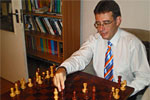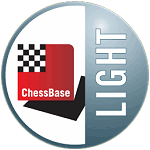
World Championship 2007 Mexico
The World Championship 2007 will take place from September 12 to 30 in the
Sheraton Centro Histórico Hotel in Mexico City. Eight players are qualified
– the tournament will be a double round robin. The prize fund is US $1.3
million.
Round eight commentary by GM Mihail Marin
Despite the relatively early draw, Svidler-Kramnik featured rich strategic
content. Black countered White's attempts to attack on the kingside with active
central play. The final repetition of moves was quite logical from this point
of view.
Playing with Black, Morozevich tried to remount the variation that led him
to defeat against Gelfand. He failed to do that, but saved half a point, helped
by Aronian's imprecise play during the transition to the ending. Curiously,
the final phase featured a theoretical ending that I had mentioned in my notes
to a previous round.
Gelfand-Anand ended in a draw without too much fight. Anand employed a rare
plan and obtained adequate play, but the final position was far from dead drawn
yet.
Leko's win with White against Grischuk was a rather one-sided affair. Grischuk
missed some possibilities of an early counterplay and was gradually squeezed.
After two losses in a row, he must feel how true it is that missed wins (against
Aronian and Svidler) tend to turn back as boomerangs.
Svidler,P (2735) - Kramnik,V (2769) [C42]
WCh Mexico City MEX (8), 21.09.2007
1.e4 e5 2.Nf3 Nf6 3.Nxe5 d6 4.Nf3 Nxe4 5.Nc3 Nxc3 6.dxc3 Be7 7.Bf4 0-0
8.Qd2 Nd7 9.0-0-0 Nc5 10.Be3 Re8 11.Bc4 Be6 12.Bxe6 Nxe6 13.h4 Qd7 14.Qd5 Qc6
15.Qf5
15...Qc4. A novelty over 15...Nf8 as played in the fourth round game Svidler-Gelfand.
The knight retreat looks like a solid option and eventually led to a quick draw,
but has the drawback that it leaves White free hands for developing his initiative.
If Svidler was ready to repeat the variation, he obviously had prepared some improvement.
The idea behind Kramnik's move is to question the enemy queen's domination over
the right wing as soon as possible. This will be the main theme of the next phase
of the game.
16.Kb1 g6 17.Qh3 h5 18.Nd2 Qe2 19.Rde1 Qg4 20.Qh2 d5 21.f3 Qa4
22.g4
Finally, White has managed to start a kingside attack which bears some similarity
with the sharp lines of the Sicilian Dragon. It should be noticed that his own
king finds himself in absolute safety, because of the absence of open files on
the queenside.
22...Bd6 23.Qf2 Ng7
We can also notice some differences if compared to the Dragon, which favour Black.
We have here an open file, which can always be used by the defending side for
transposing to an ending by exchanging all rooks. This could happen if White tries
to undermine Black's kingside fortress with Bd4, threatening Bxg7 and gxh5. Another
aspect is Black's advantage of space in the centre (something unthinkable in the
Dragon). Concretely, the presence of the d5-pawn restricts the activity of the
white knight.
24.c4!? dxc4 25.Bd4. Svidler has cleared the e4-square for
his knight, which can make a lot of difference after the aforementioned solution
25...Rxe1+ 26.Rxe1 Re8 because of 27.Ne4! However, the structural modifications
in the centre have also opened the d-file and the h1-a8 diagonal, which will offer
Black additional possibilities for Defence and counterattack.
25...Qc6! Indirectly defending the f6-square. 26.Bc3. Threatening
Qd4. 26.Ne4 was not dangerous because of 26...Be5 revealing the idea behind
Black's previous move. There was no time for slow increase of the pressure with
27.Re2 because of 27...Rad8 the d-file serves Black quite well for starting
his counterplay. 26...Bc5 27.Qg3 Bd6 28.Qf2. The only reasonable way
to avoid an immediate draw was 28.Qg2 , but after the opening of the long diagonal
the white queen would feel dominated by her rival. Just think about Leko's uninspired
queen retreats in his game against Gelfand! 28...Bc5 29.Qg3 Bd6 1/2-1/2.
[Click to replay]
Aronian,L (2750) - Morozevich,A (2758) [E17]
WCh Mexico City MEX (8), 21.09.2007
1.d4 Nf6 2.c4 e6 3.Nf3 b6 4.g3 Bb7 5.Bg2 Be7 6.Nc3 Ne4 7.Bd2 f5 8.d5 Bf6
Despite his defeat in the game against Gelfand, Morozevich seems to maintain
his faith in this variation. 9.Qc2
9...Na6. Deviating from 9...Qe7 , as he played in the aforementioned game.
10.Nxe4 fxe4 11.Qxe4 Nc5 12.Qe3 0-0!?
Instead of retrieving the sacrificed pawn, Morozevich opts for rapid development.
Optically speaking, his compensation looks obvious, but the absence of significant
weaknesses in White's position will allow him neutralize Black's initiative in
the next phase of the game.
13.dxe6 Re8 14.Qa3 Qe7 15.Be3 Qxe6 16.Rc1 Ne4 17.0-0
Nd6 18.Bd4 Be7 19.c5 Ne4 20.Nd2 Nxd2 21.Bxb7 Rab8 22.Rfd1 Rxb7 23.Rxd2 Reb8 24.Qe3
bxc5 25.Qxe6+ dxe6
26.Bxc5 (?!) It is hard to refrain from "winning" the
pawn again, of course, but the drawish tendency of rook endings is well known.
One important alternative was 26.Bc3 , maintaining White's advantage intact, because
of his better structure, more active bishop and the control over the only open
file.
26...Bxc5 27.Rxc5 Rxb2 28.Rd7. Threatening to invade the seventh
rank.
28...Rc8
29.a4?! The ending resulting after this move offers White no winning chances
at all. A slightly more promissing ending could have been obtained with 29.Re5
Rb6 30.Rg5! Forcing Black to weaken his seventh rank. 30...g6 31.Rc5 Rb2 32.e3
Rxa2 33.Rdxc7 Rxc7 34.Rxc7 Despite material equality, Black's position is not
easy to defend, because of his numerous weaknesses. In his days, Akiba Rubinstein
was a great expert in this kind of positons. A more recent example where this
structure arised is Karpov - Hort, Waddinxveen 1979, in which White won.
29...Rxe2
30.Rcxc7 Rxc7 31.Rxc7 a6 32.Ra7 Ra2 33.Rxa6 e5 34.a5 e4 35.Ra7 h5 36.h4
The importance of the lack of flexibility induced by this move will become obvious
at a later stage.
36...Kh7 37.a6 Ra1+ 38.Kg2 Ra2 39.Kf1 Kg6 40.Ra8 Kh7 41.a7
g6 42.Ke1 Kg7 43.Kd1 Ra1+ 44.Kc2 Ra2+ 45.Kb3 Ra1 46.Kc4 Ra2 47.Kd4 Ra1! An
important moment. Maintaining the central pawn defended with 47...Ra4+ 48.Kd5
Kh7? would lose after 49.Kc6! (Threatening Kb6) 49...Ra1 50.Rd8 Rxa7 51.Rd7+ Rxd7
52.Kxd7 with an easily won pawn ending.
48.Kxe4
As I have mentioned in my comments to the earlier game Anand-Kramnik, this
ending is drawn. Time has come to explain my comment on White's 36.h4. With
the pawn on h3 or h2, White could have created a passed pawn on the f-file,
which would ensure an easy win. However, Black could have prevented this undesirable
outcome by advancing his g-pawn to g4, immediately after White's 41.a7. 48...Ra4+
49.Kf3 Ra3+ 50.Kg2 Ra2 51.Kh3 Ra3 52.f3 Kh7 53.Kg2 Ra2+ 54.Kf1 Ra1+ 55.Ke2 Ra2+
56.Kd3 Kg7 57.Kc4 Ra1 58.Kc5 Rc1+ 59.Kd6 Rd1+ 60.Ke5 Ra1 61.Kf4 Ra4+ 62.Ke5
Ra1 63.f4 Ra2 64.f5 gxf5 65.Kf4 Ra5 66.Re8 Rxa7 67.Kxf5 Rf7+ 68.Ke4 Rf1 69.Re5
Kg6 1/2-1/2. [Click to replay]
Gelfand,B (2733) - Anand,V (2792) [E06]
WCh Mexico City MEX (8), 21.09.2007
1.d4 Nf6 2.c4 e6 3.g3 d5 4.Bg2 Be7 5.Nf3 0-0 6.0-0 dxc4 7.Qc2 a6 8.Qxc4
b5 9.Qc2 Bb7 10.Bd2 Bd6!?
This move was played only once before. Since for the time being both sides
are playing a watch and wait game, Black prepares in advance the thematic central
break ...e5. 11.Rd1. White will fail to prove an advantage with this
neutral move. We can only try to guess which was Anand's novelty over the game
Speelman-Browne, Wijk aan Zee 1983, where White obtained the better chances
with 11.Bg5 Nbd7 12.Rd1. 11...Nbd7 12.Ba5 Qb8 13.b4 e5 14.Nbd2 exd4 15.Nxd4
Bxg2 16.Kxg2 c5 17.bxc5 Bxc5 18.N2b3 Ba3 19.e4 Ne5 20.Nf5 1/2-1/2. [Click
to replay]
Leko,P (2751) - Grischuk,A (2726) [C88]
WCh Mexico City MEX (8), 21.09.2007
1.e4 e5 2.Nf3 Nc6 3.Bb5 a6 4.Ba4 Nf6 5.0-0 Be7 6.Re1 b5 7.Bb3 0-0 8.a4
b4 9.d3 d6 10.Nbd2
10...Be6. Grischuk refrains from 10...Na5 , which had led him to defeat
in the previous round. Maybe it would have been wiser to pick up a completely
different opening, in order to avoid specific preparation and the negative influence
of... bad memories. 11.Bxe6 Curiously, in most of the previous games
White refrained from this exchange. Curiosamente, en mayoría de las partidas
anteriores las blancas evitaron este cambío. 11...fxe6 12.Nf1 Qd7 13.Ng3
10...Be6. Grischuk refrains from 10...Na5 que le había llevado a la
derrota en la ronda anterior. Tal vez debío de cambíar la apertura por completo,
para evitar la preparación especifica y la influencía negativa de... los malos
recuerdos. 11.Bxe6 Curiously, in most of the previous games White refrained
from this exchange. 11...fxe6 12.Nf1 Qd7 13.Ng3
13...Na5. With this move, Grischk probably wanted to anticipate the opening
of the b-file after c3. However, the control over the centre is weakened now.
13...Rab8 would have been a worthy alternative, inviting White to declare his
intentions. For instance, 14.c3 bxc3 15.bxc3 Na5!?
14.d4. The logical reaction.
14...exd4 15.Qxd4 c5 16.Qd3 Nc6 17.c3 bxc3 18.bxc3
18...Kh8. Starting with this moment, Grischuk effectuates a series of
moves without a clear plan. Here, he could have activaed his play with 18...Ng4
, aiming to install a knight on e5 in order to control the relatively weak light
squares from the centre. The only way to cross this plan would be 19.e5!? but,
among other reasonable possibilities, Black could have answered with 19...d5!?
20.h3 Nxf2! 21.Kxf2 Bh4 , leaving White under an unpleasant double pin. The slow
(but not really easy to parry) threat is ...Rf5 followed by the transfer of the
queen to g6, in order to win the g3-knight.
19.h3 Qc7. 19...d5 looks more
active.
20.Ng5 Ne5 21.Qe2 Qc8 22.f4 Nf7 23.Nf3 Rb8 24.c4
White's progress over the past few moves is obvious.
24...Qb7 25.Bd2 Qb2 26.Qd3
Qb7 27.Bc3 Qc6 28.a5 Kg8 29.Rad1 Rbd8 White has regrouped in optimal way and
is ready for concrete action.
30.f5 e5
Strategically, White's position is close to winning. In the manoeuvring phase
that follows, Leko will combine the threats of a direct mate attack with the pressure
along the d-file.
31.Nf1 Rb8 32.g4 h6 33.N1d2 Qc7 34.Kh1 Qd8 35.Rg1 Nh7 36.Nf1
Bg5 37.Ne3 Bxe3 38.Qxe3 Rb3 39.Rd3 Nhg5 40.Nd2 Ra3 41.h4 Nh7 42.Nf3 Nf6 43.g5
hxg5 44.hxg5 Nh5 45.Bd2 Ra4 46.Qe2 Ra2 47.Qe1 Nf4 48.Bxf4 exf4 49.Qh4 Qe8 50.g6
Nh6 51.Qxf4 Re2 52.Ng5 Qa4 53.Qxd6 Qxc4 54.Qd5+ Qxd5 55.Rxd5
Nowadays, it is not so easy to mate the opponent in the middlegame, especially
at this level. However, the resulting ending is almost as good. 55...c4 56.Rd7
c3 57.Ne6 Rc8 58.Rgd1 Rd2 59.R1xd2 cxd2 60.Rxd2 1-0. [Click
to replay]
All results of the round
| Round 8: Friday, Sept. 21st 2007, 14:00h |
Peter Svidler |
½-½ |
Vladimir Kramnik |
Levon Aronian |
½-½ |
Alexander Morozevich |
Boris Gelfand |
½-½ |
Viswanathan Anand |
Peter Leko |
1-0 |
Alexander Grischuk |
| |
Current standings

Links











































